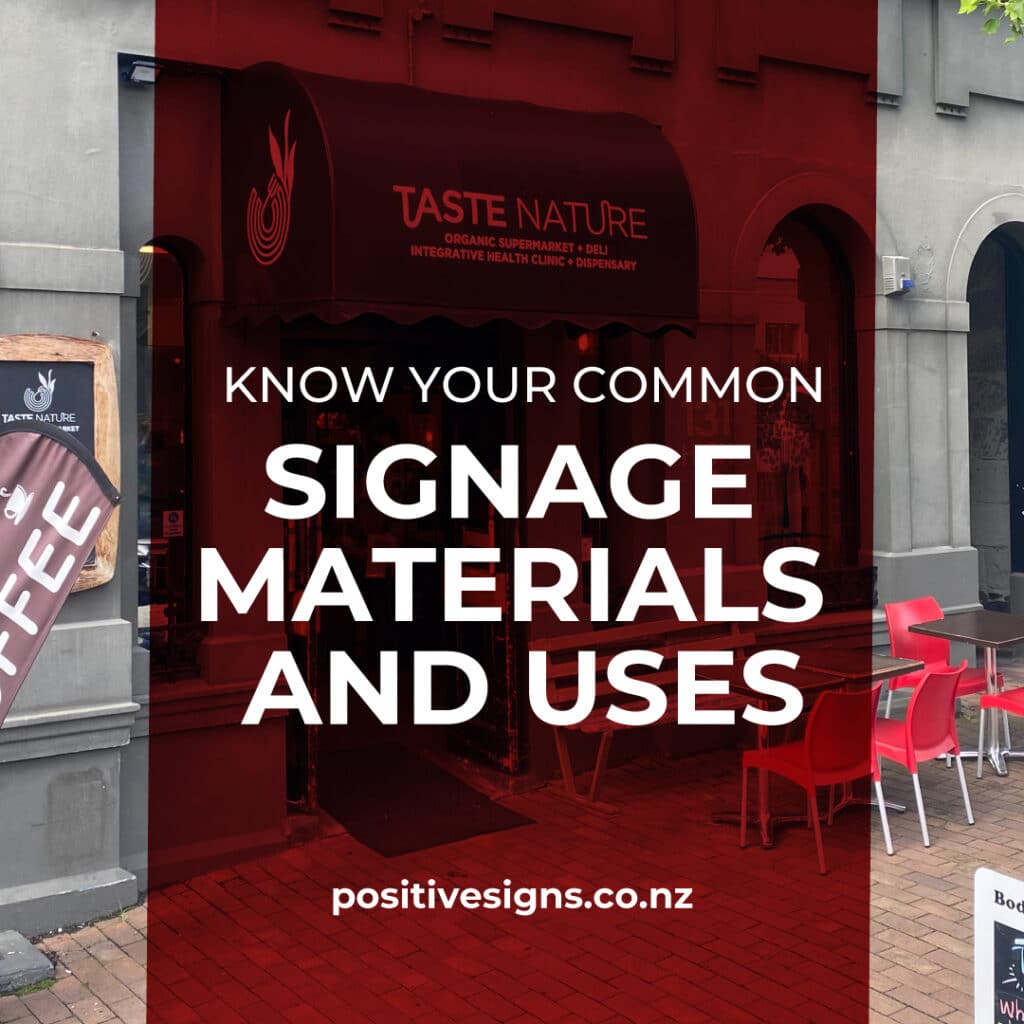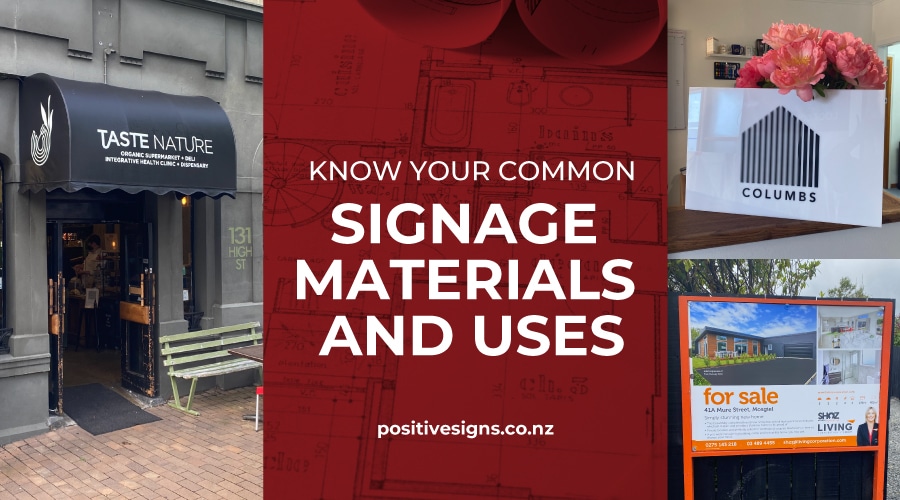You’ve got the design sorted and now it’s time to choose from the many different signage materials. The questions are flying everywhere: Which one is best suited for your use? What is your budget? How sturdy does it need to be? Is it for indoor or outdoor use?
Thankfully, we’ve got the answers. We’ll take you through the most common signage materials and explain what type of signs they are best used for.

7 Common Types of Signage Materials
We’re in the signage business and we love it. We do appreciate though, that others may not be as excited about signs as we are. So as well as sharing some of our enthusiasm, we’re also sharing a bit about the most common types of sign substrates and their differences to help you when ordering your new sign.
- ACM
ACM or Aluminium Composite Material is suitable for long term signage indoors and outdoors. Made from a polythene core which is set between two thin aluminium panels, it is flat and has minimal flex. The advantages of ACM are that it is available in a wide glossy colour range, has a flat surface, is a cost effective option and lightweight. Uses for ACM include point of sale, gate signs, hazard signs, footpath signs and site signs.
- Corflute
Corflute is a made using polypropylene corrugated sheets, or fluted plastic. It is lightweight though reasonably rigid. Corflute is a short-term signage and packaging product. It can be used outside for short periods, such as real estate for sale signs, though would last longer indoors. Sign uses for Corflute include real estate signs, site signs and even giant photo frames for your wedding or special event.
- Foamboard
Foamboard is generally used as a base onto which posters, prints, plans and images are mounted. Suitable for indoor use, it is very lightweight, reasonably strong and can be cut into a variety of shapes and sizes. Foamboard is usually made of three layers: the inside in made of polystyrene or polyurethane foam with paper on the outside. The foamboard thickness varies depending upon the inner layer thickness, making it a great way to present material in a 3D format and to keep what is mounted on the top stable. Common uses for foamboard include the mounting of construction plans for presentations, event signage, wall art prints and in picture framing.
- PVC Banners
PVC is a very versatile signage substrate. It is mostly used for creating banners, onto which designs are printed. Banners can be vertical or horizontal and in different sizes and shapes. Suitable for using both indoors and outdoors, they can be used many times. If using outdoors, use only for short periods of time as sun and wind damage can occur.
- Acrylic
Acrylic signage is suitable for long term indoor usage. Adhesive vinyl is cut and then applied to the acrylic sign, with the vinyl available in a range of colours to match your branding. The acrylic which signs are made from is very strong and difficult to scratch or shatter. It looks very appealing and professional, ideal for indoor building signage. Acrylic is also used in lightboxes, where it is professionally printed and installed inside a lightbox frame, such as a veranda sign.
- Vinyl Decals
Vinyl decals are a very cost-effective type of signage that is applied directly onto a window, board, vehicle, or wall. Your required image or wording is cut out and then ready for you, or us, to apply upon your chosen feature. Used often on store windows to display business names, opening hours and special promotions, it does last for a considerable period of time outdoors, though does fade in sun exposure. It is suitable for flat and clean surfaces.
- Synthetic Poster Paper
Synthetic poster paper is durable, waterproof and can be printed in a large format. It is suitable for both indoor and outdoor usage, is generally tear proof and is a short term signage solution. Cost effective, synthetic paper is great in situations where regular paper or even laminated paper will break down or absorb moisture. For example, a swimming instructor’s lesson plans or building plans on a construction site would be fine if they got wet if printed on synthetic paper, unlike plain paper which would rip and start breaking down.

Our design and print team are available to help you in your signage material selection. Simply let us know what you want to use the sign for, where it will be used and your budget, and we will work with you to help you make the best decision. Contact us today to chat about your sign; we’re happy to give you a quote too.
How Long Does It Take to Have a Sign Printed?
Your sign is printed here in New Zealand, so there are no long waits for overseas postage. How quickly your sign is printed will depend upon your design file. If it is ready to go and meets the required Print Guide, it can quickly get going. If you require us to help design your sign or edit your existing file, factor in that time when placing your order.
The type of sign substrate will also determine your print turnaround, as some do take longer than others. Then there is the courier timeframe to consider too.
What Type of Design File Does My Sign Require?
A print-ready file is the ideal file we want to receive from you. We typically need your file to be a:
- High resolution PDF Vector document
- Have a 2mm bleed on all edges
- Have the fonts outlined
- All the colours are CMYK
Your design file may have been created by a graphic designer, in which the print ready file is something they will be familiar with. If you are using Canva to DIY your sign design, you will also need to download it as a print ready file. Take a read through our article What Is A Print Ready File for detailed instructions on how to do this.
If the design of your sign contains photos, 300dpi or higher is preferred to ensure they are sharp and clear. Our Photo Resolution Calculator is a free tool you can use to help determine what size your photo should be if it is to be enlarged.
If you have any questions about choosing your signage materials or any other printing job, we are more than happy to help! Based in Mosgiel, we work with clients throughout New Zealand and look forward to hearing from you shortly.
